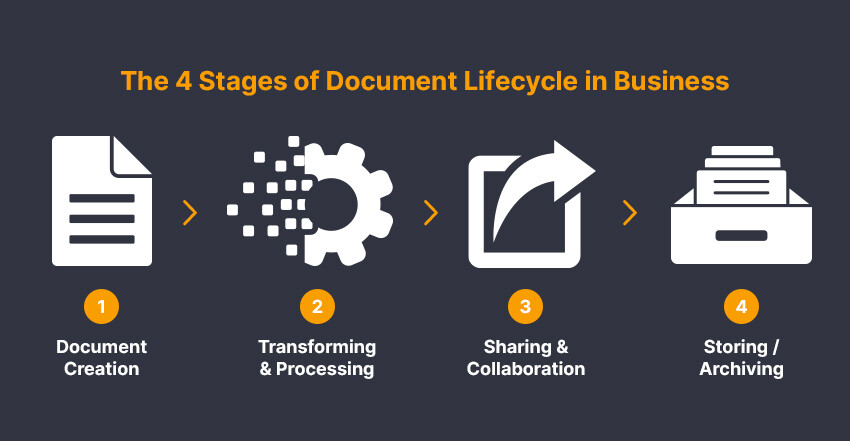Managing digital documents efficiently becomes paramount as businesses increasingly transition to digital operations. This transformation necessitates a structured approach to handling documents digitally, where email retention policies play a critical role. This guide embarks on an in-depth exploration of the digital document lifecycle within business operations, aiming to equip businesses with the strategies needed for effective digital document management. By addressing the stages of creation, storage, accessibility, security, and disposal, this guide offers a blueprint for businesses to enhance their document management practices, ensuring operational excellence and compliance with prevailing laws and regulations.
Creation and Capture
The genesis of a digital document’s lifecycle is marked by its creation or capture. This stage is critical, as it sets the foundation for how the document will be managed throughout its life. For businesses, establishing standardized procedures for document creation and capture is crucial. This includes defining templates, utilizing Optical Character Recognition (OCR) to transform physical documents to digital ones, and ensuring accurate metadata tagging for easy retrieval. An elaborate point to consider is the integration of digital signature capabilities at this stage to authenticate documents from the outset, thereby streamlining processes that require verification and approval, enhancing efficiency and security from the beginning.
Storage and Organization
After a document’s creation, its storage and organization dictate how effectively it can be retrieved and utilized. Implementing a robust digital document management system (DMS) that categorizes documents logically is essential. This not only facilitates quick retrieval but also prevents data silos. An important aspect to elaborate on is adopting cloud storage solutions, which offer scalability and flexibility. Cloud storage allows businesses to adjust their capacity based on needs, ensuring cost-effectiveness and supporting remote access, which is particularly beneficial in facilitating a mobile or remote workforce.
Accessibility and Collaboration
Making digital documents accessible while facilitating collaboration without compromising security is a balancing act. Here, emphasizing user-friendly DMS that supports version control and document sharing is vital. The role of collaborative platforms that integrate with DMS enables real-time collaboration, editing, and feedback across teams, regardless of geographical location. This seamless integration bolsters productivity and fosters a collaborative culture, which is essential in driving innovation and expediting organizational decision-making processes.
Security and Compliance
Safeguarding digital documents against unauthorized access and ensuring compliance with legal standards is a cornerstone of the document lifecycle. Beyond basic encryption and user authentication, businesses must employ advanced security measures such as role-based access control and regular security audits. A critical elaboration here is the necessity for ongoing staff training on security best practices and awareness of phishing and other cyber threats, which are often overlooked but necessary components of document security. Compliance with regulations, including GDPR or HIPAA, requires a proactive approach, where businesses must stay abreast of legal changes and adjust their document management practices accordingly to avoid penalties and safeguard customer trust.
Retention and Disposal
Determining the appropriate duration for document retention before securely disposing of them is crucial for managing digital clutter and adhering to legal obligations. Implementing document lifecycle policies, including specific email retention methods, ensures that documents are kept for a legally compliant period. The development of automated retention schedules within DMS, where documents are flagged for review or automatic deletion post-retention period, minimizes the risk of data breaches and maintains a lean document management system.
Integrating Document Lifecycle Management into Broader Business Processes
A critical aspect of establishing effective digital document lifecycles is their integration into the broader business processes and workflows. This integration ensures that document management is not a standalone activity but a seamless part of daily operations, enhancing productivity and operational efficiency. Consider using Business Process Management (BPM) software with Document Management Systems (DMS). BPM software can automate and streamline complex business processes, and when integrated with DMS, it ensures that document handling, from creation to disposal, aligns with these processes. For example, BPM can automate the workflow from requisition to purchase order creation in a procurement process. DMS ensures that all related documents are appropriately captured, stored, and disposed of according to policy. This holistic approach minimizes manual handling and potential errors, speeds up processes, and enhances compliance, creating a more agile and responsive business environment.
Role of Technology Advancements in Enhancing Document Lifecycle Management
Advancements in technology are pivotal in enhancing the management of digital document lifecycles. Innovations such as AI and ML are setting new benchmarks in how documents are handled, stored, retrieved, and disposed of. An elaborate point to explore is the application of AI in automating document categorization, metadata tagging, and even the identification of documents that are due for disposal. AI can analyze the content of documents to automatically classify them and apply relevant tags, making retrieval more efficient. Furthermore, AI-driven analytics can provide insights into document usage patterns, helping businesses optimize their document lifecycle policies and identify areas for improvement. Another technological advancement is applying blockchain technology in document management, particularly for documents requiring a high degree of security and authenticity, such as contracts and legal agreements. Blockchain can make sure that the integrity and immutability of documents, providing a secure, transparent, and verifiable record of document creation, modifications, and transactions throughout the lifecycle.
Conclusion
Establishing digital document lifecycles within business operations is a multifaceted process that demands strategic planning and execution. By adhering to email retention policies and embracing best practices in digital document management, businesses can deal with the complexities of the digital world more effectively. This ensures operational efficiency and legal compliance and positions businesses for success in a digital-centric future. As technology evolves, so should the strategies employed in managing digital documents, ensuring that companies remain agile, secure, and updated in their document management practices.






